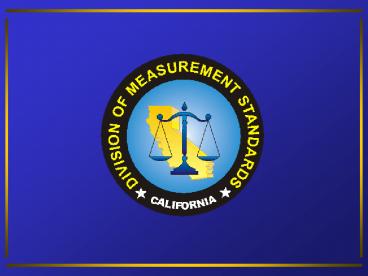TRAINING FOR THE WEIGHTS AND MEASURES OFFICIAL - PowerPoint PPT Presentation
1 / 32
Title:
TRAINING FOR THE WEIGHTS AND MEASURES OFFICIAL
Description:
training for the weights and measures official training for the weights and measures official training for the weights and measures official this module will ... – PowerPoint PPT presentation
Number of Views:90
Avg rating:3.0/5.0
Title: TRAINING FOR THE WEIGHTS AND MEASURES OFFICIAL
1
(No Transcript)
2
TRAINING FOR THEWEIGHTS AND MEASURES OFFICIAL
COURSE CURRICULUM
3
TRAINING FOR THEWEIGHTS AND MEASURES OFFICIAL
COURSE CURRICULUM
4
TRAINING FOR THEWEIGHTS AND MEASURES OFFICIAL
Module SevenBasic Weighing Measuring
Principles
Seventh in a series of 14
5
General Overview
- This module will introduce you to the physics and
mechanics applied to weighing and measuring
devices.
6
Module Objectives
Understand basic lever principles and their
application to scale construction
Be familiar with strain gauge technology and its
application to load cell construction
Identify and understand the different types of
non-automatic and automatic weight indicators
Acquire a basic understanding of liquid and gas
measuring principles
Be able to describe different types of flow
meters and their recommended applications
7
Weighing Principles
8
Weighing Principles
Trading in the early ages led to the development
of this type of appliance to compare weights.
The records of history show that the influence of
scaleswas felt as far back as 5000 to 6000 B.C.
9
Weighing Principles
Attempts at placing the loads above the beam
supported on a fulcrum from below were
impractical until in 1669 a French mathematician
named Roberval developed the Roberval balance
10
Weighing Principles
11
Weighing Principles
12
Lever Principles
13
Types of Levers
14
Types of Levers
In scale design, the second class lever is used
only as a multiplying lever. The second class
lever load pivot is between the fulcrum and power
pivots. The location of the load pivot is
determined by the desired ratio of the lever
15
Types of Levers
The third class lever is used only as a reducing
lever. Thepower pivot is placed between the load
and fulcrum pivot
16
Weighbeams
17
Dial Scales
- A variety of methods are used in the construction
of round faced dial scales - Floating pendulum
- Inverted floating pendulum
- Pivot fulcrum system
- Cam system
- The dial is the picture of the indicator travel
and predetermines the scales sensitivity
18
Strain Gauge Technology
Load cells, or transducers, now lie at the heart
of every electronic weighing machine. Each load
cell contains thin, metal foil electrical
resistors, known as strain gauges. The resistor
configuration is called a Wheatstone Bridge
Circuit
Precision load cells are manufactured for a wide
range of products, from a sensitive and delicate
scientific balance to a weighbridge for a train
19
Strain Gauge Technology
20
Types of Load Cells
21
Weighing Indicators
Auxiliary indicators are often added to
weighbeams to speed up the reading of the weight
balanced
22
Measuring Principles
There are two official sets of volume measures in
the United States wet and dry. Gallon is the
basic unit of liquid measure. A U.S. gallon is
231 cubic inches. The U.S. fluid ounce is 1/16 of
a U.S. pint Since liquids have a definite volume
but no fixed shape, they will flow and take the
shape of their container. Gases have no fixed
volume or shape and will expand to fill their
container Measuring devices in use today are
designed to move product as quickly and
accurately as possible without compromising basic
units of measure
23
Flow Meters
- There are many types of flow meters
- Vortex (Vortex Shedding)
- Coriolis
- Positive Displacement
- Turbine
- Mass
Flow -
Sonic -
Magnetic Flow
24
Flow Meters - Vortex
25
Flow Meters Coriolis Principle
26
Flow Meters Positive Displacement
Positive displacement meters will work over wide
viscosity ranges, with minimal accuracy shifts
27
Flow Meters Turbine Flow Meters
28
Other Metering Considerations
Cavitation Cavitation in a liquid flowmeter will
take place when the local pressures fall close to
or below the vapor pressure of the liquid
product Viscosity Viscosity, a resistance to
flow, can complicate measurement with many meter
types. Meter flow ranges can be adversely
affected and performance can shift when viscosity
changes occur Air Elimination Air passing through
a flowmeter is measured just as if it were
liquid. Air eliminators aid in the removal of
air and other gases
29
Other Metering Considerations
- Flow Straighteners and Conditioners
- Flow straighteners and conditioners can smooth
out turbulent and transitional flows and help
meters measure more accurately - Temperature
- Temperature changes greatly affect the volume of
a gas and correction are necessary - Altitude
- Atmospheric pressures changes with altitude
requiring corrections for accurate measurement of
gases
30
Summary
Weighing Principles Lever Principles Indicators Lo
ad Cells
Measuring Principles Type of Flow Meters Metering
Considerations
31
Conclusion
This training module has provided you with a
better understanding of the principles of physics
and mechanics applied to weighing and measuring
devices.
32
TRAINING FOR THEWEIGHTS AND MEASURES OFFICIAL
This Concludes Module 7Basic Weighing
Measuring Principles































